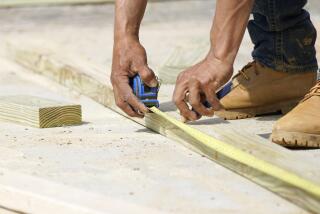Home Improvement : Hone Money-Saving Skills in Remodeling
- Share via
Like any building skill, saving money on home remodeling projects is a technique that improves with practice. Here are tips from Roger Bennett and Michael Morris, both experienced do-it-yourselfers:
Shop around for the best prices.
“My wife didn’t swing a hammer, but she spent many hours shopping around for materials, which added up to considerable financial benefits for us,” says Bennett, an architect with experience in renovating homes.
“Prices for most building materials fluctuate from month to month, so you have to be alert to cut the best deal,” says Morris, editor of Home Mechanix magazine and an experienced carpenter. People have learned to get three bids when seeking a contractor. “It’s the same thing when it comes to buying materials.”
Lately, he adds, prices have been fluctuating downward because of a building recession. Don’t wait to see an ad for a good price. You may, but if you don’t, call or make a visit.
In a slow economy, watch for going-out-of-business sales.
Morris profited when a local lumberyard closed by buying lumber at a very good price and stockpiling it. When you do find a good price, try to lock it in even if you aren’t ready to take delivery. He used this ploy to get his roof shingles.
Negotiate better deals with suppliers and contractors.
After you’ve got an estimate from a contractor, ask what you can do yourself to cut the price. By taking on the time-consuming process of securing permits, as the Morrises did, you may be able to lower the cost.
Shop around for bank financing.
Even in hard times, a bank is in business to make loans, says Morris. Bank terms vary, so look around.
Buy used components for your project.
“So much secondhand material is still good,” says Bennett. “New doors are selling for $50 to $150. I bought old ones for $15 at a house wrecker’s. I’ve got six-panel, two-panel and four-panel doors, but they don’t seem to clash.”
Construction steel, hardware and plumbing fixtures are also available used at great savings, he adds. A steel I-beam costs hundreds of dollars new, $50 used. The designs of some fixtures, however, have been improved recently, so new ones are preferable. Toilets have improved considerably and they aren’t that expensive, Bennett says.
Look for problem sites.
These days, land may be one of the most significant expenses for a new house. “I suggest sites that are rocky or wet,” says Bennett. “Both are problems for builders and so are often left over after the more buildable parcels are taken. A troublesome site may be workable if you put up a smaller house.”
If you’re shopping for a house instead of land, you have a negotiating advantage when it’s in poor repair.
“There aren’t so many people who are willing to fix the roof and so on,” Bennett says. But be cautioned, before you negotiate, make sure you understand what’s involved in the repair and don’t bite off more than you can chew.
More to Read
Inside the business of entertainment
The Wide Shot brings you news, analysis and insights on everything from streaming wars to production — and what it all means for the future.
You may occasionally receive promotional content from the Los Angeles Times.










